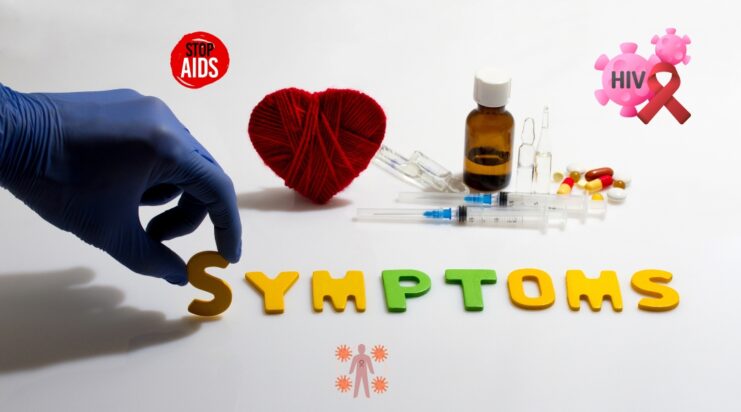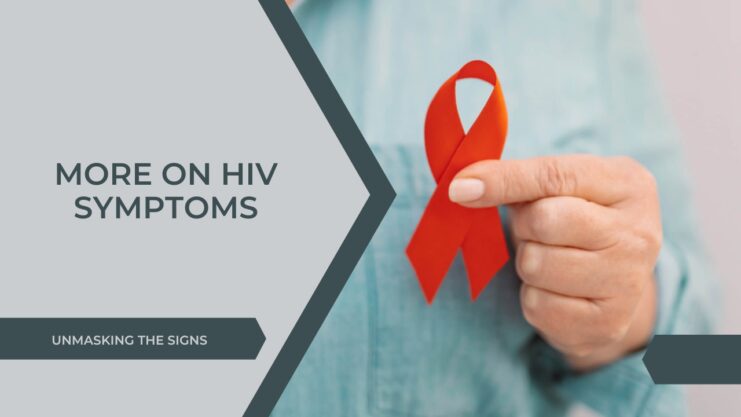When individuals discuss ‘HIV symptoms,’ they’re typically referring to the signs that emerge shortly (within 2 to 6 weeks) following HIV infection. These early indicators don’t stem from the infection directly, but rather from the body’s immune response to the infection. This is why such symptoms may resemble or be identical to those of other infections.
These symptoms are collectively known as Acute-Retroviral Syndrome (ARS), with other names including acute primary HIV illness, acute HIV syndrome, and Acute Sero-Conversion Syndrome. This differs from late-stage AIDS symptoms, which can take years to develop.
What are the early symptoms of HIV infection?
Because the whole body is reacting to fight off the virus, it is not surprising to find a variety of symptoms affecting all bodily systems.
- General – Fever, Sweats, Lethargy, Malaise, swollen lymph nodes, weight loss
- Skin – Rash, ulcers, Sore throat
- Digestive – Nausea, Diarrhea, Loss of Appetite
- Neurological – Headache
- Musculo-Skeletal – Muscle aches, Joint aches
Not everyone will develop all these symptoms. These symptoms can develop in varying combinations. The most common symptoms are fever, sore throat, rash and swollen lymph nodes.
Only 40% to 70% of people infected with HIV will develop ARS symptoms.
Who gets HIV ARS symptoms?

It is estimated that between 50% to 90% (some say 40% to 70%) of people who have been infected with HIV will develop HIV ARS. There is no way to predict who will develop ARS and who will not.
When do HIV symptoms appear and how long do they last?
HIV symptoms can appear anytime between 2 weeks and 6 weeks after infection. Most people who do develop the symptoms do so at 3 weeks.
Symptoms generally last for at least 2 weeks but have been known to last up to 10 weeks.
‘Flu-like’ is not ‘Cold-like’
HIV ARS symptoms are often described as ‘Flu-Like’. Many people think having a Flu is similar to having a Cold and this has led to a lot of confusion.
Many patients see me for minor cold symptoms such as running nose, sore throat or a mild cough and are worried to death about HIV. These are Cold symptoms, they are not Flu symptoms.
For those of you who have had the Flu before, you will know what I am talking about. With the Flu, you will be very sick. The fever is high and persistent, the body ache is very bad and you literally cannot get out of bed.
To be more precise, ARS is also described as mononucleosis-like symptoms.
The HIV ARS Rash

This is a great source of worry for many people I see. I have seen people coming in with literally one tiny red dot on their forearm convinced that it was a HIV rash. It is not.
The HIV rash usually comes on 2 to 3 days after the onset of the fever and lasts for at least 2 weeks. It is a Morbiliform (looks like measles) Exanthem rash consisting of macules and papules up to 1cm in diameter which are pink to red in color. Each lesion remains discrete and does not become confluent.
It is widespread and always (100%) involves the upper thorax and collar region also commonly (60% to 40%) affects the face, arms, scalp, thighs and palms in descending order of frequency.
Basically, the rash is BAD. Your friends and colleagues are going to take one look at you and ask ‘Hey why do you have a rash? Go see a doctor. If you have to hunt for individual spots or patches randomly on your skin, it is not an HIV rash.
The HIV ARS Fever
Where do I start? I have patients measuring their temperatures hourly and freaking out when it hits 37.1⁰C because they read somewhere that ‘normal body temperature’ is 36.9⁰C and therefore they have a fever and therefore they have HIV. That is paranoia.
The HIV ARS Fever is high, usually above 38.5⁰C when taken from the ear. The HIV ARS Fever is long, usually lasting for at least 2 weeks most of the time longer. It is usually associated with other symptoms such as lethargy, malaise, muscle aches and joint aches.
The HIV ARS Lymph Nodes

This is another great source of worry. I have seen patients who cannot stop rubbing their necks feeling for lymph nodes and melting into a panic state whenever they feel a lump that they have not felt before.
First of all, you can feel normal non-enlarged lymph nodes, especially in thin people. So being able to palpate a lymph node does NOT mean it is enlarged.
Enlarged lymph nodes are about 1cm in diameter. In HIV ARS, there are usually many of such lymph nodes in the neck, groin and underarms. They are usually tender (i.e. painful to touch).
How to Deal with the Symptoms of HIV ARS
Dealing with the symptoms of HIV ARS may require a multifaceted approach. Rest and hydration are vital as your body works to fight off the infection. Over-the-counter pain relievers may help with discomfort from fever and aches. However, it’s essential to consult a healthcare provider before starting any new medications, even those sold over the counter.
Eating a balanced diet can help bolster your immune system and provide energy for your body. If you’re experiencing a loss of appetite, try eating smaller, more frequent meals throughout the day.
Remember, while these tips can help manage symptoms, they are not a substitute for medical advice. It’s crucial to seek medical attention if you’re experiencing symptoms of HIV ARS, particularly if you’ve had potential exposure to the virus.
The Importance of Regular Testing and Safe Practices
Regular HIV testing is essential, especially for those who are at higher risk of contracting the virus. This includes people who have multiple sexual partners, those who engage in unprotected sex, and people who use intravenous drugs. HIV testing allows for early detection, which in turn leads to early treatment and a better prognosis.
Safe practices can significantly reduce the risk of contracting or spreading HIV. This includes consistent and correct use of condoms during sex, never sharing needles, and getting tested regularly if you’re sexually active with multiple partners. It’s also possible to take pre-exposure prophylaxis (PrEP), a daily medication for people at high risk of HIV to prevent the infection.
The HIV ARS Sore Throat and Mouth Ulcers

The sore throat associated with HIV ARS is bad. It is not a little discomfort in the throat or the sensation of having to clear your throat. It is painful. If you ever had Strep Throat before, it feels like that.
It is commonly described as an exudative tonsillitis. In other words, you will be able to see a white or yellow pus-like substance on the tonsils. The tonsils themselves will be red and swollen. About 20% of the time, there are also ulcers round to oval in shape, 5mm to 10mm in diameter with a white base and red halo on the inside gums, tonsils or roof of the mouth.
Anxiety can frequently cause the muscles around the throat to tighten leading to some throat discomfort. This is NOT HIV.
What other diseases have the same symptoms as HIV ARS?
First of all, the Flu. And by that, I mean an Influenza infection, not a cold. See above for details.
HIV ARS symptoms also mimic the symptoms of infectious mononucleosis very closely (also known as Mono or Glandular Fever). HIV ARS symptoms can also be mistaken for an acute Hepatitis A or B infection, Parvovirus infection, Cytomegalovirus infection and Toxoplasmosis. It can even be mistaken for Rubella (German Measles).
Conclusion
The only way to know for sure if you are infected with HIV or not is to get tested. Until that is done, try not to worry about your symptoms.
If you have to worry, then worry if you fulfill the following criteria:
- You had a high-risk exposure 2 to 6 weeks ago
- You have a fever above 38.5⁰C that just does not go away
- You have multiple small red spots covering your face, neck and upper chest
- You have a really bad sore throat with ulcers in your mouth
- You have been diagnosed with another STD like Gonorrhea or Chlamydia
Related Posts:
- Cough, Sore Throat and Rash – Are These Signs of HIV or ARS?
- Unmasking the Secrets: Urethral Swab STI Detection
- Finding How To Track A TextNow Number - Unmasking…
- Men’s Human Papillomavirus (HPV) Testing: Unmasking…
- The Meaning Behind the Upside-Down Pineapple: More…
- More Info on Throat Gonorrhea: The Hidden Reality












